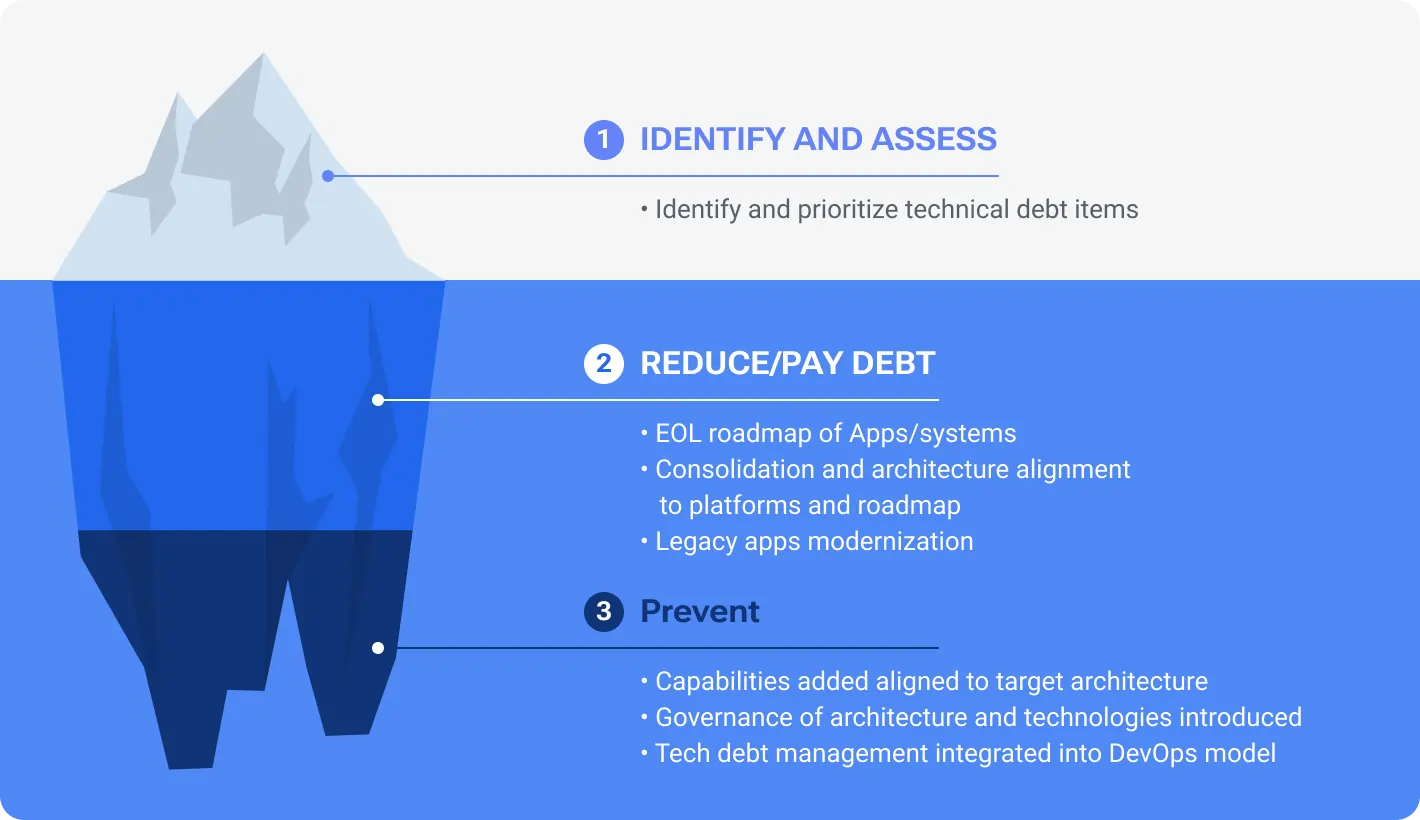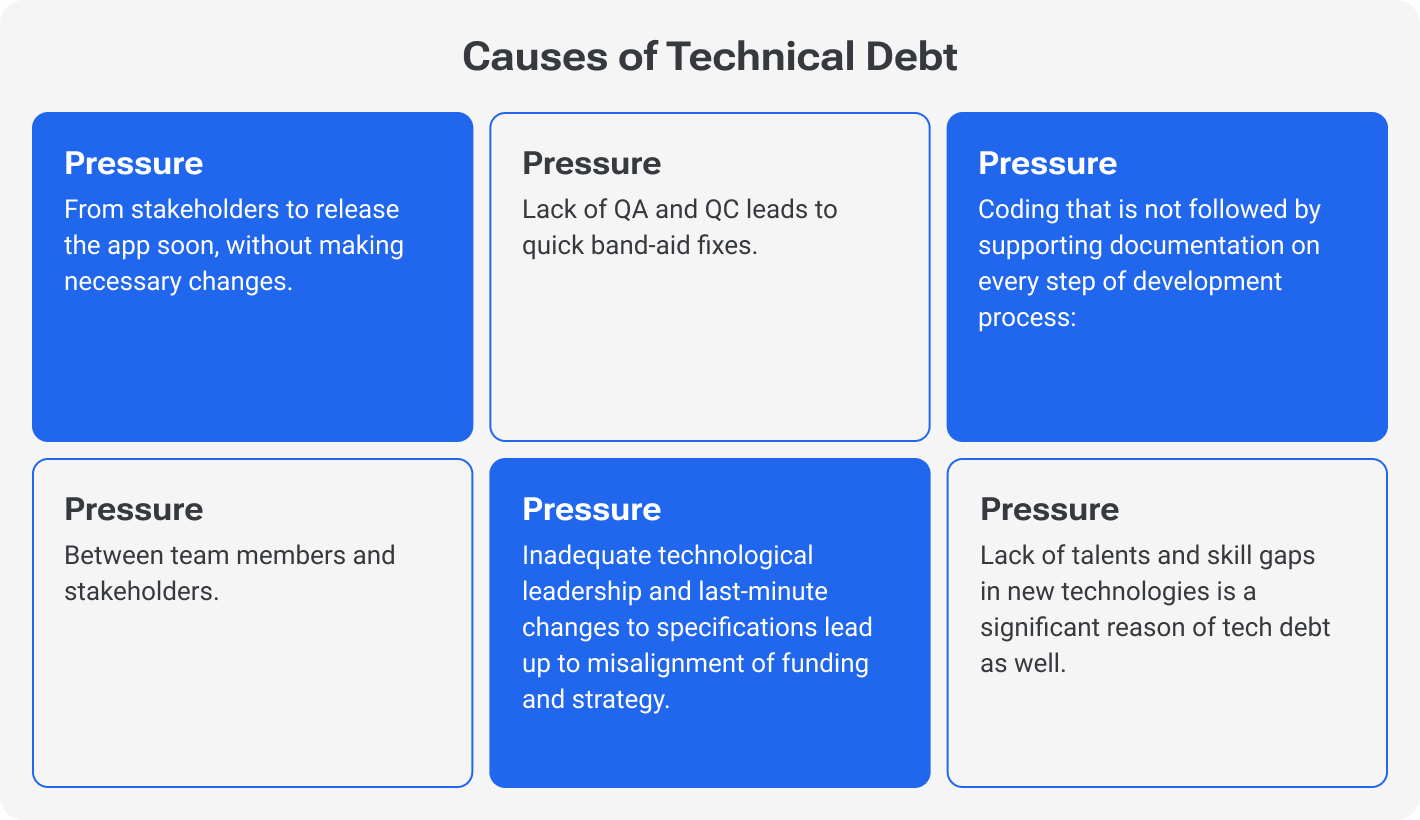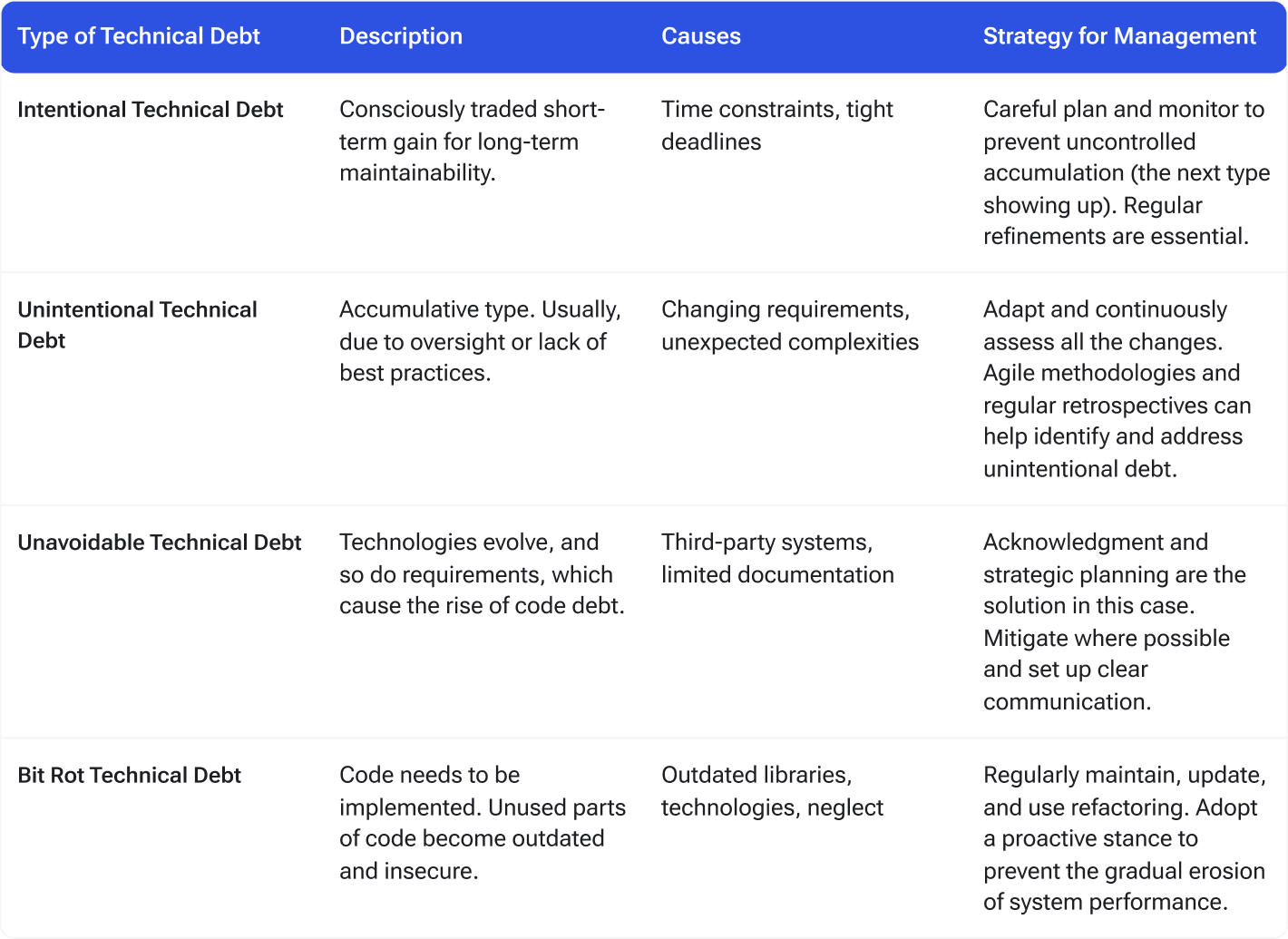Outsourcing to Czechia

How much does it cost to hire developers in Czechia?
Dec 2nd 25 - by Devico Team
Find out how much it costs to hire software developers in Czechia in 2025. Compare hourly rates, roles, and factors that impact pricing.
Hire
Hire by role
Hire Front-end developers
Hire Back-end developers
Hire Full-stack developers
Hire Android developers
Hire iOS developers
Hire Mobile developers
Hire AI engineers
Hire ML engineers
Hire Automation QA engineers
Hire Blockchain developers
Hire Data engineers
Hire Cloud engineers
Hire by skill
Hire JavaScript developers
Hire TypeScript developers
Hire Ruby on Rails developers
Hire React Native developers
Hire Flutter developers
Hire Golang developers
Hire React.js developers
Hire Python developers
Hire PHP developers
Hire .NET developers
Hire Java developers
Hire Laravel developers

Tech debt
February 01, 2024 - by Devico Team
Summarize with:
Recall a popular iOS app Pet Pix. If you are in the dark about it, it’s the one that turned your boring selfies into hilarious animal caricatures. The app went viral for a while. Any can say that it’s a splash. But as operations continued, the server encountered a high activity. Software features experienced malfunctions, system updates led to failures, and a growing wave of customer dissatisfaction threatened to escalate. The root of these challenges was the impact of technical debt that had been accrued during a period of aggressive and rapid product development. Fixing it became a costly, months-long nightmare, ultimately derailing Petpix's momentum.
And it’s not a single case. A 2020 study by Sonar revealed that technical debt costs USD 1.5 M per project for a period of five years. Another stats showed that nearly 78% of companies spent more time addressing technical debt-related problems than in the previous year.
And what’s even more interesting is that technical debt doesn’t have a single definition. It refers to a catchall that covers everything from bugs to legacy code. It covers even documentation tech specialists have lost.

Understanding what technology debt is — paramount for any stakeholder in a company involved in software development. As we just said in the previous passage, tech debt doesn’t have a one-and-only definition because it covers too many things. Since we started with metaphors, let’s proceed with another one.
Imagine you are building a card house, and you are competing with your friends: whoever builds it more reliably and faster wins. You have made up a plan: you put not one card at a time, but two at a time, in the shape of the top of a triangle. Yes, this may help you build the house faster, but usually rushing often results in the collapse of the whole house.
Something similar we can see with a technical debt infrastructure. It arises from prioritizing speed over quality. Rushing through features with subpar coding practices, inadequate documentation, or skipping crucial testing might meet immediate deadlines, but it leaves behind a shaky system riddled with hidden issues. At their essence, tech debts encompass all the corners cut and compromises made during the SDLC.
Managing technical debt is not about avoiding it altogether but rather about making informed decisions. You can compare it to investments. When you put your money where your mouth is, you learn to assess every action accurately.
Another remarkable comparison is a road trip with the risk of a breakdown increasing with every mile. Similarly, ongoing managing technical debt is better than mulling over the problems in an after-deployment stage.

Software development is a field that is rather logical than creative, right? Not, of course. That’s why technical debt impacts the end product in so many ways. Because devs also create tech solutions in many, sometimes unexpected ways. So, code debt can arise from various factors; it's the consequence of specific development practices gone awry. Let’s look at the root and make the reasons clearer.
Software development is a very dynamic field. Many studies confirm devs often suffer from burnout. Deadlines often loom large, pressuring teams to deliver quickly. This pressure inevitably leads to rushed development, and wrong priorities when delivery speed is more important than long-term maintainability. For instance, a developer might opt for a crutch (temporary solution) to meet a release deadline, but at the end of the day, you get code that lacks robustness and clarity.
Imagine you have got a 1000-piece puzzle without a guide. Something similar is when coders receive a verbal task, without proper documentation. A lack of technical docs, or even outdated documentation, can transform a once-transparent codebase into a maze. Outdated documentation becomes a source of confusion and errors, leading developers down rabbit holes in debugging phantom bugs.
Testing is a reassurance, something like a safety net that catches potential issues before they reach end-users. But the truth is that there is also inadequate testing, though. Whether due to time constraints or oversight, this results in undetected bugs and vulnerabilities that may lay dormant during development. Fixing such issues is a costly thing.
Project requirements can evolve, sometimes gradually and other times abruptly. This move is known as scope creep. Simply put, it occurs when project requirements and functionalities balloon beyond the initial plan. This constant evolution makes it difficult to maintain a stable and cohesive codebase.
These factors are only a few from a wide list. But if you zero in on such issues with the intention to prevent them, you’ll definitely win this game.
To make it easier to understand a tech debt topic, people often narrow all the types to only two ones. But in fact, there are at least four main software technical debt types. Let's categorize and explain them in the table below.

Let’s think back to 2014. A group of researchers noted that the actual frameworks in classifying code debt don’t address the debt's unique characteristics. During the research, they proposed to classify a tech debt according to its nature. In their document, there were 13 different categories of debt, along with a set of critical indicators for each. But over time, for the sake of simplicity, tech people started to distinguish only four main types, joined into quadrants. The technical debt quadrants provide a framework to assess the nature of the particular technical debt, aiding in the mitigation strategies. Let's break them down.

The first quadrant to comprehend is deliberate but reckless technical debt. It is when devs or tech team as a whole cut corners with full awareness of the consequences but without a prudent plan for repayment. Usually, it also happens when developers overindulge with crutches to meet a tight deadline, fully aware that it might lead to future complications. Mitigating this type of debt requires vigilance, regular reviews, and a commitment to addressing issues promptly.
The second quadrant houses opposite tech debt — prudent and deliberate. Here, decisions are made consciously, with an understanding of both the short-term benefits and the necessity for repayment. In other words, devs consciously incur debt for a strategic benefit, but they do it responsibly, with clear payback plans and risk management measures. This is like taking out a mortgage to buy a house — a calculated move with potential long-term rewards.
The third quadrant comprises inadvertent but prudent technical debt. This quadrant shows the situation when unforeseen circumstances or lack of awareness make all the plans go down the drain. Maybe, not so dramatic, but you got the message. Developers might choose an approach without anticipating the potential long-term consequences. To avoid such a faux pas, cultivate a culture of continuous learning, retrospectives, and adapting processes.
Last but not least — reckless and inadvertent technology debt. This is the riskiest territory, where shortcuts are taken without full awareness of the potential consequences. This is like driving with a flat tire — oblivious to the damage and heading for a nasty blowout.
The core message of this article we want to get across is be aware of tech debt and ways to mitigate debt-related issues. It is especially important for stakeholders in the software development lifecycle since the impact of technical debt on businesses can be significant, affecting both short-term and long-term outcomes.
In the short term, technical debt can manifest as delayed releases, increased bug counts, and a higher likelihood of system failures.
Slower development cycles: Bugs, tangled code, and outdated documentation become roadblocks, slowing down feature implementation and bug fixes. Endless debugging and technical firefighting waste precious time.
Increased maintenance costs: Patching up technical debt is like constantly mending a leaky roof. Bug fixes become iterative, demanding ever-increasing resources and delaying progress on new features.
Decreased code quality: In the modern tech market, quality is king. And poor code, along with accumulated technical debt, leads to reputational and hence financial losses.
Degraded user experience: Mentioned bugs and performance issues, which are consequences of technical debt, directly impact users. They get frustrated, dissatisfied, and finally get away from you.
Software Improvement Group, in its report, states projects with a high level of technical debt experience at least 20% reduction in productivity. This is due to the time spent on bug fixing and resolving debt-related issues.
Looking to the long term, the consequences of technical debt become more pronounced. As a project matures, the weight of accumulated debt can hinder scalability, making it increasingly challenging to adapt to evolving business requirements.
Missed market opportunities: What a feeling when you lose the boat. Slower development due to technical debt can make you feel exactly like this. Missing opportunities can have severe financial and reputational repercussions.
Increased security vulnerabilities: A codebase riddled with technical debt becomes a breeding ground for security flaws. Exploitable vulnerabilities can lead to data breaches, financial losses, and irreparable damage to user trust and brand reputation.
Unscalability: You don’t plan stagnation, do you? So, as your project grows, technical debt hinders scalability and flexibility. Adding new features or adapting to changing demands turns into a monumental task.
Demotivation and burnout: Developers working with a messy, debt-ridden codebase experience frequent frustration and inefficiency. This can lead to decreased morale, burnout, and high turnover, further crippling your project's progress.
Some industry studies share the thought that for every dollar spent on new development, an additional USD 3 is required to address technical debt-related issues.
Technical debt examples and how to solve them
If we have only one piece of advice for any business owner with tech debt issues, we’d suggest taking a proactive position. Adopt proactive strategies that prioritize code quality, sustainability, and adaptability — these are essential moves for effective tech debt management. Yet, here are some more best practices.
Monitoring and Feedback Loop
Implement monitoring tools to track system performance and identify potential issues.
Establish a feedback loop where monitoring data informs development teams about the real-world impact of their code.
Use performance metrics to guide ongoing refinements and address emerging technical debt.
Attract Many Specialists To Code Review
Take advantage of a collaborative code review culture where team members actively participate.
Discussions on design decisions, potential improvements, and identification of technical debt mustn’t be taboo.
Don’t put away feedback after code reviews, and use it for regular refinements.
Robust Testing Is Must-Have
Prioritize comprehensive test coverage to catch issues early in the development process.
Test-driven development (TDD) could be your best friend in this adventure. It makes tests written before code implementation.
Automated testing tools can streamline the testing process — use them.
Documentation Standards
Maintain clear and up-to-date documentation for code, APIs, and system architecture.
Encourage developers to document their work thoroughly, including the reasoning behind design decisions.
Regularly review your documentation. This will help you to ensure accuracy and completeness.
Agile Development Principles
Agile methodologies are proven to be one of the most effective ways to manage fast-paced processes and tasks.
User feedback is king. Use it in ongoing development cycles.
Use sprint reviews and retrospectives to address and mitigate technical debt.
You could ask: is software technical debt good or bad? If you dig on the Internet, you’ll get many vague answers like — it is not good or bad. On the one hand, it’s correct because code debt is rather a challenge that demands a proactive, strategic approach. But on the other hand, if something damages your business, how can it be good or even neutral? Let’s recap the keystones from the article.
There are various types of technical debt: deliberate, unintentional, unavoidable, and bit rot, and it is important to recognize them for developing targeted mitigation strategies.
Both short-term and long-term consequences of technical debt necessitate immediate action. You can use the mentioned instruments to fix such issues: continuous refactoring, robust testing, clear documentation, and agile development principles.
But remember, a proactive approach is key. Regular code reviews, automated debt tracking, open communication, and continuous improvement are the pillars of a sustainable debt-free future.
Outsourcing to Czechia

Dec 2nd 25 - by Devico Team
Find out how much it costs to hire software developers in Czechia in 2025. Compare hourly rates, roles, and factors that impact pricing.
Outsourcing to Czechia

Nov 25th 25 - by Devico Team
Compare Czechia and Poland for software outsourcing in 2025. Discover costs, talent, infrastructure, and which country fits your project best.
Outsourcing to Czechia

Nov 18th 25 - by Devico Team
A complete guide to outsourcing software projects to Czechia, learn about costs, talent, benefits, and how to build successful partnerships in 2025.